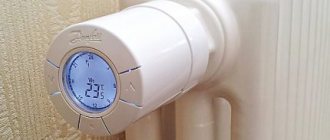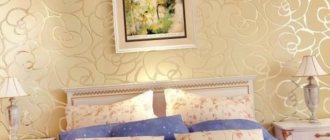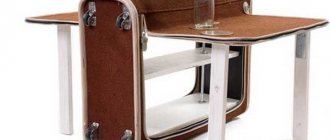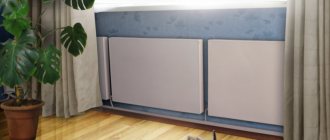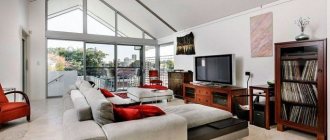How to close a radiator: interesting ideas
When planning to close a heating radiator, it is necessary to take into account a number of the following conditions:
- Due to the disruption of proper air circulation, the battery efficiency will decrease. This will happen in any case, regardless of the method you choose. The difference lies only in the percentage of thermal energy loss.
- The minimum circulation of convection currents should remain. The deficiency will be reflected in uneven heating of the room and fogging of windows.
- No one is immune from possible leaks and other emergencies. Therefore, all threaded connections and the radiator itself must be within reach. The decor can be a removable or easily dismountable structure.
- You should also consider in advance the possibility of free access to the tap, thermal head and other elements of the heating system.
Painted radiator Source cloudfront.net
Healthy! You can increase the heat transfer coefficient of a heating radiator in a simple way. To do this, a foil material is placed between it and the wall, which will reflect thermal energy toward the house, thereby improving air circulation indoors.
There are many options for hiding a heating radiator in a bedroom, nursery or kitchen. Let's analyze the most popular of them:
- Mounted and attached screens.
- Curtains.
- Coloring.
- Decoration with textiles.
- Coloring, artistic painting.
- Fabric screen.
We hide and disguise heating radiators. Interesting solutions
For those who have decided to save time and money on reconstructing the heating system and replacing cast-iron radiators with modern ones, we offer several ways to hide, disguise, decorate and update old unsightly radiators. You will be surprised how much these “cast iron heavyweights”, when transformed, can refresh the interior.
Successful camouflage is a simple but effective idea for those eyesores on heating radiators. Just choose a paint that matches the walls and paint the radiator with it. Alkyd and acrylic enamels, as well as water-dispersion paints, are best suited.
Or you can do the opposite - use paint not to disguise the battery, but to focus on it.
At the height of the heating season, a radiator can become a potentially dangerous object in the house. To prevent a child from accidentally touching hot metal, special screens were invented that prevent direct contact with the battery and play a decorative role in the interior.
In addition, the screen will prevent dust and dirt from entering the battery. So cleaning will no longer be so burdensome.
The easiest way to fit batteries into the interior of a room is to hide them in a plasterboard box and cover it with a decorative grille. Of course, decoration should be done in such a way as not to disrupt the operation of the heating system.
Special perforated MDF panels are the most versatile of radiator screens. A wide variety of shapes, shades and textures allows you to choose them for any interior. Such screens are lightweight, compact, moisture-resistant, and environmentally friendly.
A screen with strict shapes is also considered a classic.
Laconic wooden screen models without elaborate decor will look good in a modern interior.
You definitely don’t want to hide such a decorative metal frame for a radiator behind curtains. Because it will definitely attract the eyes of guests and will become the undeniable “highlight of the program.”
If you have carpentry skills, the idea of a decorative screen for a radiator can be developed into an improvised rack, console, or cabinet. Functional furniture is worth its weight in gold in small-sized homes.
Glass can also be used to make not just radiator screens, but also beautiful elements of functional furniture.
Some have thought of using a battery covered with a screen as an additional place to rest. Warm, cozy, beautiful.
The radiator and heated towel rail can be turned into an art object. Sometimes it is difficult to guess what a heating system looks like.
The yellow square is not a painting, but a battery.
We suggest trying to solve the problem of unsightly batteries on your own, for example, using decoupage. Wash the battery thoroughly, make its surface smooth - it is not necessary to completely remove the old paint. First paint it with regular white enamel. While the battery is drying for 24 hours, take a decoupage card with a design you like. Measure the width of the outer surface of the battery section, cut the card into strips of the required size. Using PVA glue diluted with water in a 1x1 ratio, glue the motif so that it is located exactly in the middle of the battery. Paint the remaining part without a pattern on top and bottom with acrylic paints. When the paint is dry, the entire battery must be coated with heat-resistant varnish.
You can cover the battery in an original way using a folding frame, inside of which strips of fabric are intertwined.
Needlewomen can sew some funny cover for the radiator. For example, let an unaesthetic metal battery turn into a sheep or other cute animal. The children will definitely be delighted.
A radiator curtain is a good alternative if you don’t want to use bulky frame screens. For a decorative curtain, choose a fabric that matches your decor. Sew one part of the fabric Velcro to the top of the curtain, and glue the other to the bottom of the window sill above the radiator. You can make several curtains and change them depending on your mood.
A simple and original way to disguise a battery is using a curved sheet of plywood 4 mm thick. The panel is attached to the wall with 4 screw hooks at a distance of at least 5 cm from the window sill, so as not to interfere with normal air circulation. In order to get a beautiful bend, the panel must be twice as long as the radiator, and its center must be placed strictly in the middle. Apply decorative self-adhesive furniture film to the front side of the panel.
It is easy to make a universal retractable panel from a fiberboard sheet, which, if necessary, can be easily moved to another room. It is installed behind the frame frame. The frame requires fiberboard boards 1.6 cm thick and 8 cm wide. The horizontal and vertical parts of the frame are glued together.
If the masking panel is first covered with dark paint and then varnished, you will get a drawing and note board for children. You can also decorate the panel with an applique, a picture, or cut out a school of fish in it.
In one of the Moscow apartments there is such a fake fireplace made of plywood, made with your own hands. It covers an old cast iron battery.
The transformation happened like this. From plywood they built the “face” of the fireplace with a window for the firebox, as well as a firebox with a picture of bricks. Then the decor of the floor and cornice was made from polyurethane skirting boards. A long LED lamp was installed to illuminate the firebox. The lamp housing was painted with splashes of orange and red paint. The coals represent large stones from the hardware store.
On our portal you can read about unusual multifunctional radiators and how to prepare for the heating season. Watch a video about the combined heating system. And go discuss all issues of choosing and installing radiators in the appropriate section of the forum.
Hinged and side screen
One of the most practical and popular methods. It is distinguished by a variety of methods and a wide selection of models, the classification of which is carried out according to several criteria. First of all, this is the material of manufacture:
- Metal. Manufactured from perforated metal sheets. The workpiece is coated with a layer of powder paint, the quality of which depends on the service life of the product. With high-quality staining, it can last for decades. From a practical standpoint, metal is the best choice for maintaining normal heating of the room. It heats up quickly, after which it begins to explore thermal energy itself.
- Forged metal. The decorative grille is very impressive. Due to the fact that it does not visually cover the radiator, a background screen is used inside. Most often, this role is performed by a classic perforated sheet metal grille. To enhance the emphasis of the openwork of forged lines, the background can be painted in a certain color that matches the interior. The advantage of this decor is aesthetics, the disadvantage is the high price (compared to conventional grilles). Practical properties are similar to sheet metal products.
- Tree. Natural materials are perceived as a symbol of luxury and elegance. A wide selection of colors, styles and shapes allows you to choose a grille to suit almost any interior style. The price range is also wide, from simple economy options to premium ones made from elite types of wood. Due to the fact that the surface of the radiator is more hidden, the room is heated more slowly than in the case of metal.
- MDF or HDF. A laminated wood surface made from softened wood particles. They differ from each other in strength (the latter is more rigid and not so susceptible to mechanical damage). Due to the fact that the surface of the grid is more perforated than that made from natural wood, the panels have greater heat transfer.
- Plastic. In terms of ease of use, the material is the most practical. Heat-resistant plastic is resistant to prolonged heating up to 80°C, wet cleaning, and is resistant to the use of chemically active detergents. In terms of throughput, it is no different from HDF boards, second only to metal.
- Glass. The worst option for making a grate if you plan to save on heating costs. It has a low heat transfer rate, but has a spectacular appearance, which is favored by many owners of the corresponding interiors. They are absolutely safe, as they are made of tempered glass and can have not only a matte surface, but also an original pattern or design.
- Combined. Manufactured using two materials. The most popular are radiator grilles with a wooden frame and a decorative surface made of HDF.
Screen for radiator attached to the wall Source miaprovence.ru
Hinged screen with internal circulation Source rackcdn.com
Interesting! It is found in materials for radiator grilles and exotics. Bamboo or rattan panels, although rare, are no exception.
The following classification is carried out due to the design of the products, on which the appearance and method of installation depend. The list is also huge; the most popular options include the following:
- Flat. They are used in plasterboard structures when the battery is installed in a niche. The flat plane of the grating is fixed along the bars placed along its perimeter. Glass products are secured using pins mounted into the walls. Another name for such grilles is a façade for heating radiators.
- Mounted. There are two types: with or without a solid top cover. Installed on batteries protruding from the plane of the wall. In most cases, they are fixed to the top of the radiator with special hooks.
- Box It has the poorest heat transfer capacity. They completely cover not only the visible part of the battery, but also block the air circulation. Movement is carried out only due to perforation, which may not be enough for high-quality heating of the room. There are two types: in the form of a kind of mini-cabinet-chest of drawers, leaning against the wall and standing on its own legs. The second option – hanging type – is fixed to the wall.
DIY decor made from laminate Source vdome.club
All presented options for radiator screens can be characterized as follows:
- A simple solution is to completely or partially “hide” the battery.
- They can be used as a separate decorative element.
- Easy to install and subsequently use.
- Provide protection from burns and other damage.
- They affect the efficiency of the heating system in different ways.
The listed options for decorative radiator grilles are not a complete list, but only the most popular models. In addition to them, there are products made independently and their appearance, method of fastening and functional characteristics can be completely different.
Curtains to the floor
The most popular way to hide a heating radiator is the method of hanging curtains. This allows you not only to remove them from the line of sight, but also (in some cases) to forget about their existence. The main thing is to choose the optimal material and color that matches the style of the room.
Principles of thermal engineering and masking of batteries
To learn how to cover a heating radiator with a screen, an absolute understanding of the laws of heating engineering is not necessary. It is enough to comprehend simple truths:
- Heating of the room is carried out through a combination or separate use of two techniques: convection and infrared radiation.
- Convective heat exchange ensures uniform heating of the air, and infrared radiation transfers heat to surrounding objects.
- Any method aimed at closing the radiators beautifully leads to losses in heating power. For example, a glass screen with artistic painting completely solves the problem of decorating heating appliances, but the temperature in the house will immediately drop. The reason is that glass almost completely neutralizes infrared radiation.
The more reliably the heat exchanger is disguised, the greater the heat loss will be. This fully applies to blind reflectors, which prevent the spread of infrared radiation and convection.
The picture is the same with blank panels covering the top of the batteries - they completely block the path of warm air, that is, the principle of convection does not work. Hence the conclusion, which is also the answer to the question of how to cover heating radiators in an apartment - the cover should have more holes, so heat loss will be minimal.
Additional requirements
Screens also play the role of protection, because the temperature of the coolant is quite high. This is especially true for centralized heating systems, where values can reach +100°C. The use of protective grilles is justified primarily in children's rooms.
Simple screen models are inexpensive, so purchasing them is not a problem. Installation also won’t take much time, especially since almost everyone has a workshop in their garage with a minimum of tools. However, certain requirements should be taken into account when choosing and installing:
- It is necessary to ensure the accessibility of communications and heating devices, which is important during operation and repair. Plumbers believe that gratings should not be fixed; attached screens are best.
- High-quality screens do not become an obstacle to the passage of heat; on the contrary, they only contribute to the dissipation of heat flow.
- Products should not contain toxic components that can be released under high temperatures.
- Good products are not subject to deformation even with strong heat.
Wood products are considered the best choice when purchasing gratings.
If you haven’t yet decided how to hide the battery under the window, then this product is perfect. Plastic screens, especially from lesser-known manufacturers, may contain harmful toxic elements. The issue of authority is not an issue for them, so the use of low-quality components in the pursuit of excess profits is not ruled out.
Coloring, art painting
The technique is considered one of the most attractive from the point of view of maintaining the amount of heat transfer. In addition, it does not require installation work to install the box. The disadvantage is that painting the radiator is not safe for children. The sharp metal corners of the radiator will remain uncovered.
Artistic painting Source stat01.com
The range of varieties of heat-resistant paints allows you to choose the color that best suits your interior and quickly paint over the white surface of the radiator. The result will not be long in coming, even if it is not possible to completely replicate the background of the walls. A little lighter or darker – it doesn’t matter. The main thing is that this is no longer a white “spot” against the background of, for example, a dark wall.
It is not necessary to give the batteries the color of the wall surfaces. With their help you can create a unique decorative element. It is enough to draw a burning fireplace, a shelf with some object or something else on them. The drawing can be different, from a banal image of a piece of furniture to an original landscape or still life.
Fabric screen
Another option for an effective way to decorate a heating radiator is to sew a fabric screen. The technique is advantageous in that, in comparison with rigid perforated screens, it transmits more heat, being inferior in this indicator to the open principle of coloring.
The easiest way to attach the material is to install ordinary Velcro under the window sill or in its lower part. Whether to do these down or not depends on the chosen material. Heavy canvases can hang under their own weight, light ones will sway as a result of the slightest air movement and stickers are required for them.
For kitchen
An example of how to hide a heating radiator in the kitchen.
Fireplace painted on a kitchen radiator Source build-experts.ru
An example of battery decor, symbolizing exactly what it is needed for. The warmth and comfort that one associates when looking at logs burning in the fireplace favorably emphasizes the “domestication” of the room. The element of artistic painting for a kitchen radiator can be different: flowers, landscapes, original patterns - exactly as much as your imagination is enough for. Let us remind you that when using this technique, use only paint that is resistant to prolonged heating (heat-resistant).
Radiator decor in the kitchen interior Source forcemontage.ru
Attached decor for the radiator. Fixation to the wall is carried out using brackets located inside the structure, for which the middle part is removed. There are many options for such models, so choosing the right one will not be difficult.
A hanging screen of this type can be used in rooms for various purposes. The original front surface makes it a unique individual idea of the designer. This happens due to the fact that the model is not yet as popular as versions with horizontal or classic cross-shaped coverings.
The following example will be useful for decorating a room in a loft style. The design consists of a conventional built-in screen installed in previously prepared frames made of plasterboard, brick or other material. Note the presence of ventilation lugs at the top of the case. Without them, normal air circulation will be difficult.
Hinged screen for battery Source rezzba.at.ua
Loft-style kitchen with a hidden radiator Source www.ntkrz.com
Radiator in the kitchen-living room Source interiorsib
To create a successful interior, it is not necessary to remove the radiator from visibility. In some cases, for example, when it is located in a bay window, it will be enough to accent it with a different color. As it is shown in the interior of this kitchen-living room.
For the bedroom
A decorative grille for a bedroom can be made of different materials. The design style is also varied. The choice in this case should adhere to the principle of the rest of the interior of the room. The example shows the decor of a room designed in a strict classical style.
In the bedroom, as in any other room, heating radiators can be built into the wall. For this purpose, special niches left during the construction of walls or plasterboard frames assembled by hand are used. The main surface of the structure is finished in the color of the walls, and a decorative grille made of plastic, MDF or HDF is inserted into the opening for the battery.
Heating radiator decor for a classic style bedroom Source wixstatic.com
Radiator built into a gypsum board housing Source pinimg.com
Screen for battery made of natural wood Source prom.st
A good design option would be a design made of wooden slats. Their location can be either vertical or horizontal, depending on the preferences of the owners.
Another example of battery decor that is suitable for both classic and many other interior styles. Making such a design with your own hands will be problematic. It is much easier to order ready-made. The variation in execution may be different, based on the stylistic orientation of the room.
It is not necessary to hide the heating source in a closet or cover it with screens. The owner of this premises decided to use another, no less original method. Having arranged a full-fledged sun lounger above the radiator, he simultaneously solved 2 problems: he organized an additional resting place and removed the battery from visibility.
Furniture for decorating a heating radiator Source pinimg.com
Original and practical battery decor Source propertyshutters.com
For children's
Let's look at several popular methods for decorating a battery in a children's room.
A metal screen that can protect your baby from hot surfaces and sharp corners. You can look for this or a similar composition in construction stores or buy a classic one and repaint it in the desired color. The effect will be the same.
Metal screen for a children's room Source Sztukateriapolska
Battery-dog in the interior of a children's room Source remoskop.ru
Painting a radiator the same color as the walls for a children's room may seem trivial. Therefore, you can use the examples provided and create a complete picture. True, due to the peculiarities of the drawing, in order to understand its meaning, you have to carefully look at what is drawn.
The battery may be completely hidden under the window, as is the case in this room. In this case, the wooden frame looks more like a kind of cabinet, and only after close attention does its purpose become clear.
The classic metal screen body is completely devoid of decorative elements. The decoration is a magnetic sticker in the form of a set of multi-colored pencils, reminiscent of the interiors of Soviet kindergartens, where each section of the cast-iron radiator was painted in the form of a separate pencil.
Battery hidden under the window Source pinimg.com
Metal screen with decorative magnet Source cloudinary.com
New life for a cast iron radiator in a nursery Source pikabu.ru
Those classic “cast iron pencils”. Color may vary.
How to hide a battery in a room
With the technical requirements sorted out, design issues begin. First of all, you need to pay attention to the color. Often on a colored wall, a white radiator looks like an eyesore. A white radiator looks harmonious on a white or very light wall. If this is a modern model, then there is no need to hide anything. They simply blend into the background. They simply don't exist.
A white radiator only looks good on a white or very light wall. On the rest it needs to be painted to match the wall
If the color of your walls is far from white, but the walls are plain, everything is solved simply. Select heat-resistant paint that is similar in color. If you hit the right tone, it’s perfect; if not, that’s okay too. A difference of two or three tones in one direction or the other does not matter. Here are some examples in the photo.
If you choose the right color, then there are simply no radiators in the interior (click on the picture to enlarge its size)
What to do if there is a drawing on the walls. Nowadays, if they glue wallpaper with ornaments, it’s usually on one wall, or at most two. The rest are covered with plain or almost plain wallpaper with different textures. Then you can stick strips of one or another wallpaper onto the radiator plates. Which ones you need to look at, as they say, “on the spot.” Cutting out the strips is not difficult; you can lightly bait one first and then the other. And in this way, empirically, determine what will look more harmonious.
It turned out very harmoniously to wallpaper the radiators
The most correct way from a design point of view is to recess the radiator in a niche, and then cover this niche with a screen. But it must be from wall to wall, and the same color.
If the depth of the resulting niche and the level of illumination of the room allows, you can make a table out of it. In this case, you can generally use a fabric screen for the radiator.
How to hide a heating radiator (click on the picture to enlarge its size)
Another way to hide the battery is to cover it with some kind of functional structure. Naturally, it should be lattice. For example, give the screen the appearance of a chest of drawers, attach shelves to the side, as in these photos.
One option is to make the radiator screen look like a piece of furniture (click on the picture to enlarge its size)
One option is to make a closet that reaches the height of the window sill across the entire width of the room. One part of it will cover the radiator - the second will actually serve for storing things.
Such a cabinet, up to the window sill, will disguise the heating radiator and will serve for storing things
A more difficult method to implement correctly is to decorate the radiator under the fireplace. It is important not to overdo it with details. For example, here is a screen in the form of a fireplace. This structure is assembled from sheets of plywood, then covered with film.
How to decorate a radiator under a fireplace with your own hands (click on the picture to enlarge its size)
The middle part is simply an attached piece of paper with the appropriate coloring. Looks great in the photo.
How to decorate a radiator under a fireplace with your own hands (click on the picture to enlarge its size)
The most common way to decorate radiators standing along one of the walls is an attached screen. It can be made of wood or MDF. But he looks ridiculous alone. More details are needed that will justify its location in this particular place. Here are some ideas that might be helpful to you.
Just placing the screen near the wall is the same as writing: “here we hide the radiator” (click on the picture to enlarge its size)
Screens are also used to decorate heating devices under window sills. But covering only part of the wall is the same as writing in large letters “we are hiding the radiator.” And the main task is to hide it, and not stick it out. What is the difference can be seen in the photo.
If the screen is from wall to wall, or the entire width of the window, it will not attract attention (click on the picture to enlarge its size)
Recent trends do not exclude the use of screens. This is still the most affordable way to hide your battery. The main idea when decorating radiators is that everything should be logical. If the screen is either the entire width of the window, or, if necessary and possible, then from wall to wall. Color and stylistic solutions have changed. If frames are needed, they should match the mesh. You can create contrasting or eye-catching frames when the room has the same color and style frames on other objects.
In some cases, the decorative grille may not match the tone of the walls, but the tone of the window frame and window sill. But here the style must also match.
Factory options or the best way to close heating radiators in an apartment or house
Modern industrial decorative grilles fit well into a residential interior, while simultaneously masking unsightly heating devices. The price of most copies is quite acceptable, all that remains is to make the right choice.
Hinged shields with top cover
Most often they are made of metal. Inexpensive products are made of painted iron, more expensive ones are made of stainless steel. The advantages of such panels include:
- Ease of installation - knowing how to cover a heating radiator with a decorative screen, the main work can be done with your own hands without the help of specialists.
- No obstacles to heat transfer - almost all products are manufactured with holes to improve convection. The shape of the holes is for every taste.
- Manufacturability - hinged panels are designed for one- or two-sided pipe connections.
Flat panels
The most common category, which is used to decorate heating devices located in niches. At the same time, such grilles play a decorative role in the interior of residential premises. In stores you can find a large assortment of screens with various designs, carvings and forgings, some of them can be compared to works of art.
Made of wood
Such false panels are ideal for any interior. If you have experience assembling at least small gazebos for your summer cottage, then the problem of how to hide the battery with your own hands does not exist for you. Products can also be made to order, in some carpentry workshop.
Wooden structures will help to withstand the elegant component of country style or all the rigor of classicism. When thinking about the topic of how to cover heating radiators in your own apartment, it is worth remembering the cost of handmade individual work - it is several times higher than consumer goods copies.
And yet, deformation of the wood due to temperature changes and humidity fluctuations cannot be ruled out. You can avoid such consequences only by purchasing a product made from high-quality wood.
Made of metal
Such fences attract, first of all, their affordability. The design component of such products is quite primitive, which is why they have a low price. However, despite this, they perform their function fully.
The panel is made of a thin sheet of metal, which can be painted in any color. More expensive specimens are made of stainless steel; their appearance is aesthetic and elegant.
Made of plastic
Taking into account the affordability of plastic products, you should not count on their durability. Moreover, not all of them meet the standards, as a result of which, when heated, they can release a bunch of harmful substances.
Box screens
You can find out how to hide a battery in a room from photos of similar interiors. However, even modern heating devices do not always correspond to the design concept of the room. Then you have to completely isolate them “out of sight.” Box-shaped grilles are classified according to the type of material from which they are made.
MDF screens
One of the most common options for decorating heating appliances. Craftsmen who know how to carefully cover a heating radiator with a screen insist on this particular material. The MDF structure is not as difficult to maintain as wood, and is easy to install with your own hands.
An important advantage of such products is that their cost is 50-70 percent less than wooden ones. And this with characteristics that are not inferior to analogues made from natural wood.
Glass panels
The glass screen looks very aesthetically pleasing and can easily complement the stylish design of any room, including a corporate building. Depending on the appearance, glass panels are divided into:
- Matte.
- Transparent.
- Plainly colored.
- With unique photo printing.
Of course, the glass structure is fragile, so manufacturers produce samples with a thickness of at least 6 mm. For greater safety, you can buy tempered glass; it combines mechanical strength and heat resistance. Even if the panel manages to break, the fragments will be small and have blunt edges.

